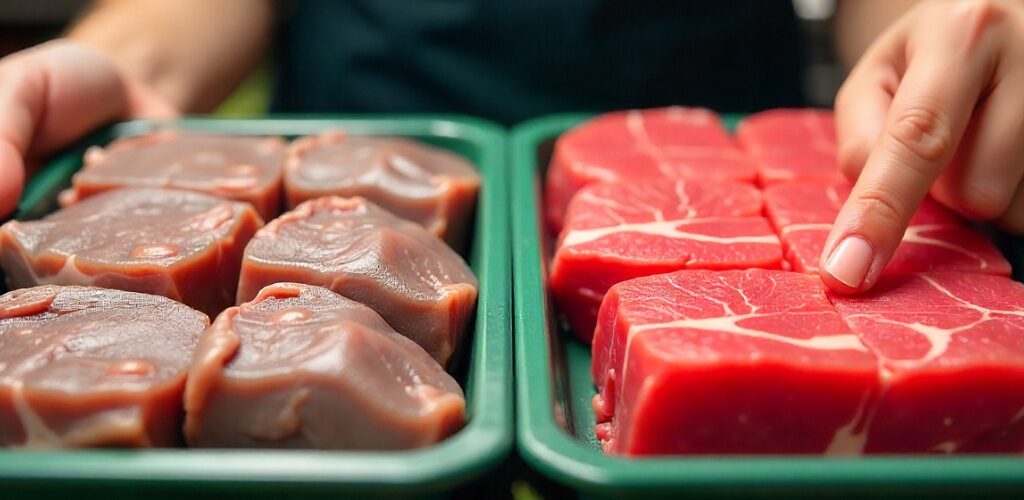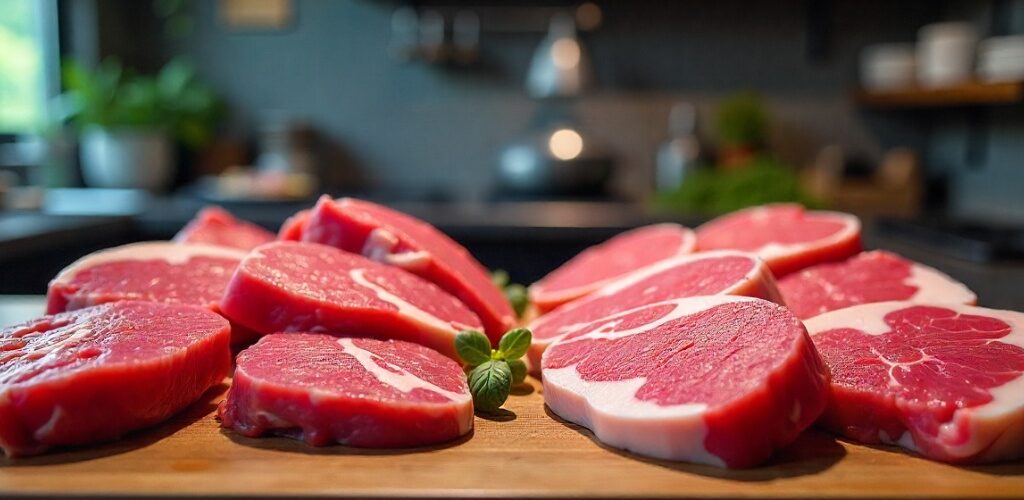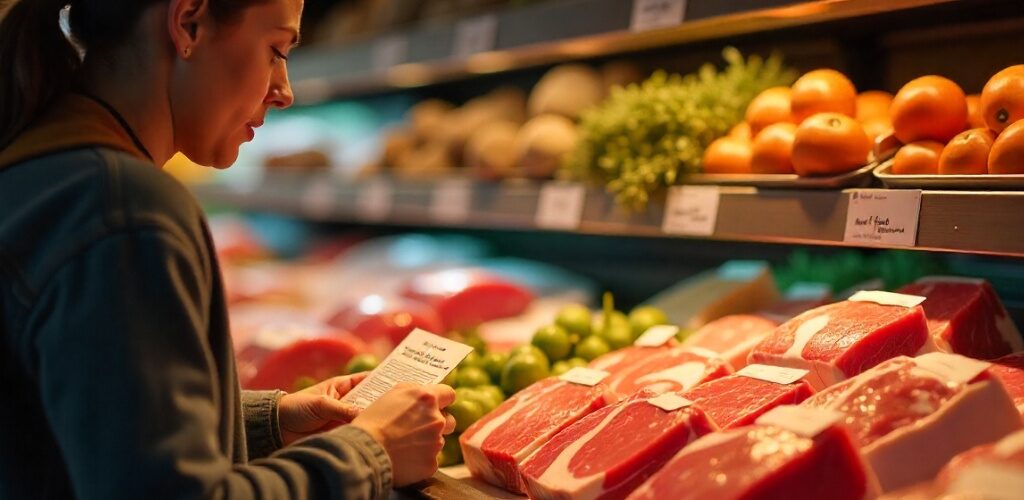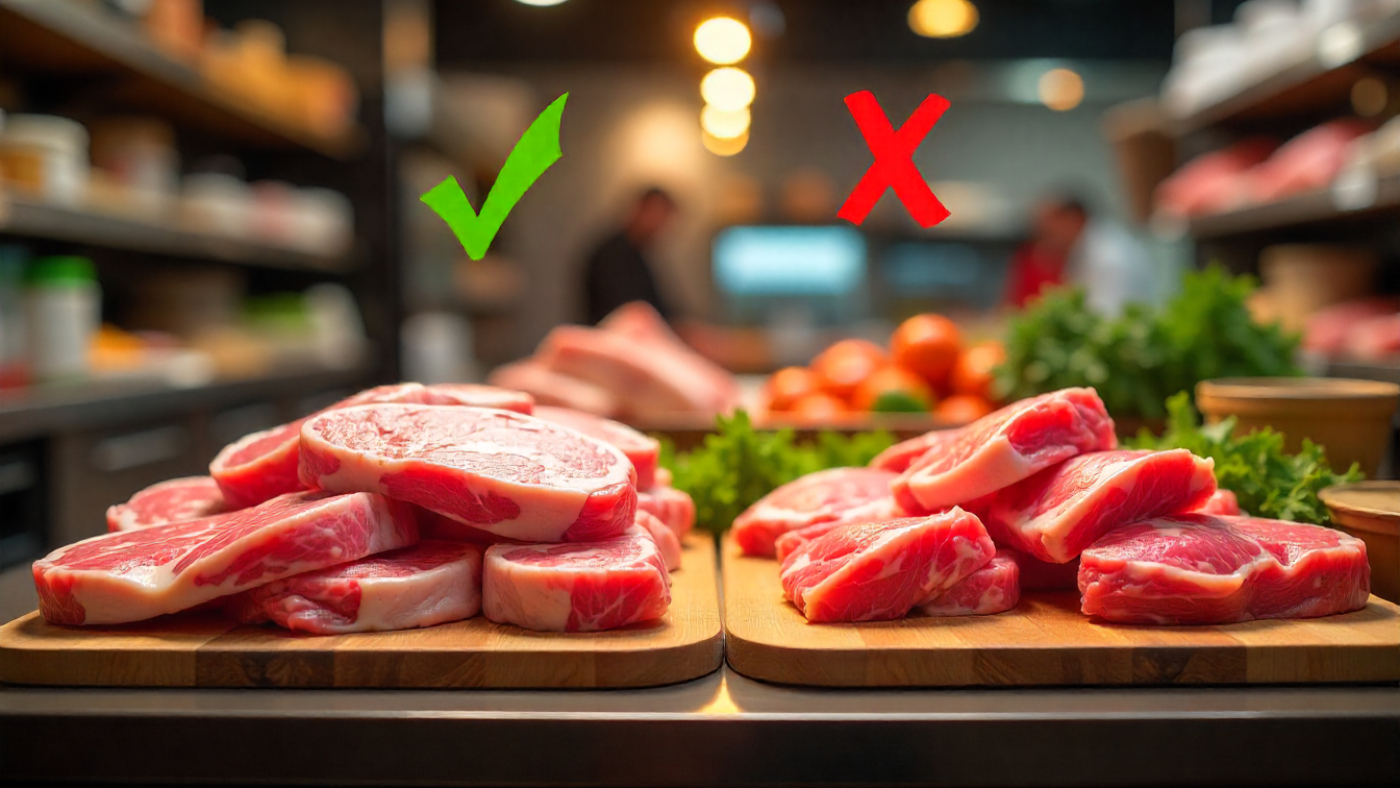Table of Contents
Let’s be honest: We all want the best for our families, our businesses, and ourselves when serving up a plate of food. Yet, buying meat is one of those everyday tasks where it’s easy to go wrong. It starts with good intentions but can end with bland meals, unhappy dinner guests, or worse—health and safety issues that no one wants to face.
Ever wondered why the steak in the restaurant tastes better than what you make at home, even when you think you’re buying the same cut? Or why your chicken ends up rubbery, or your roast too tough? The culprit is often hidden in the way meat is chosen at the source.
Here are the top 7 mistakes people make when buying meat—and actionable, simple ways to sidestep them for better, tastier, and safer meals every time.
1. Not Checking Freshness Properly

Mistake: Many buyers grab whatever is available, only glancing quickly at expiration dates or ignoring telling signs like odd colors, sliminess, or off smells.
Why it’s a problem:
- Old, discolored, or foul-smelling meat means it’s near or past its prime. This not only affects taste but also poses health risks.
- Poor-quality meat can affect the texture and tenderness of cooked dishes.
- Nutritional value decreases as meat ages vitamins and proteins degrade over time.
How to avoid :
- Always look for meat with a bright, fresh color. Poultry should be light pink beef, a vibrant red; and lamb, a deep rose.
- Avoid any meat that looks gray or has green spots.
- Check both the “sell by” and “use by” dates.
- Trust your sense of smell and ask the butcher for advice if you’re unsure.
2. Overlooking the Importance of the Right Cut

Mistake: Choosing the wrong cut for the recipe is a classic blunder. Some cuts are perfect for grilling, others need slow-cooking; mix them up, and the results are usually disappointing.
Why it’s a problem:
- Repeated failures with the wrong cut can make cooking feel discouraging, especially for beginners.
- Using a lean cut for a recipe that needs marbling leads to dryness.
- Tough, sinewy cuts end up chewy when not cooked correctly.
- Using an inappropriate cut can ruin the dish.
How to avoid :
- Get to know a few basic cuts and their ideal uses (e.g., ribeye for grilling, brisket for braising).
- If unsure, ask your butcher or trusted supplier like TK Meatwala for recommendations.
- Don’t hesitate to specify the cooking method when ordering—quality butchers will help match the cut to your recipe.
3. Ignoring the Source and Quality of the Meat

Mistake: Buying meat without caring where it comes from, how it was raised, or how ethically it was sourced.
Why it’s a problem:
- Poor farming practices lead to fattier, less nutritious, or even unsafe meat.
- Poor-quality meat can affect the texture and tenderness of cooked dishes.
- Poor-quality meat may contain hormones, antibiotics, or contaminants that can affect your health.
How to avoid :
- Choose suppliers who are transparent about sourcing, such as TK Meatwala.
- Look for grass-fed, free-range, or ethically sourced options whenever possible.
- Research the supplier’s reputation and ask questions about their butchering and handling practices.
4. Focusing Only on Price (and Not Value)

Mistake: Picking the cheapest meat without considering quality, freshness, or wastage.
Why it’s a problem:
- Cheap meat often comes from lower-quality sources, or includes more fat, water, or bone than actual edible meat.
- Poorly sourced or overly processed meat may have reduced vitamins, minerals, and protein content.
- Bargain meat may be closer to expiry, forcing you to cook it quickly or risk spoilage.
How to avoid :
- Compare value, not just price—fresh, well-sourced meat will have less shrinkage and deliver better results.
- Pay attention to the yield: some seemingly affordable options lose a lot of volume when cooked.
- Consider that quality meat can enhance your dishes so much that you end up using less (and enjoying more!) in the long run.
5. Neglecting to Check Packaging Integrity

Mistake: Not inspecting the packaging for leaks, tears, or excess fluid.
Why it’s a problem:
- Damaged packaging may mean contamination or exposure to bacteria.
- Spoiled or unsafe meat from compromised packaging ends up in the trash instead of on the plate.
- Excess liquid inside packs often signals old or mishandled meat.
How to avoid :
- Inspect for tight, leak-free packaging—whether you buy in-store or online.
- Avoid packages with too much trapped liquid (“purge”), as this usually means moisture loss and potentially bland, dry meat.
- At TK Meatwala, sealing is done in hygienic conditions to preserve flavor and safety.
6. Misunderstanding Labels and Grades

Mistake: Glossing over meat labels or misunderstanding terms like “grass-fed,” “organic,”
Why it’s a problem:
- “Grass-fed” and “organic” have specific meanings—real versions of these are more nutritious, but imitations abound.
- Grading systems like “prime,” “choice,” and “select” help indicate marbling and tenderness in beef—but are often ignored.
- Some sellers use misleading language or non-standard terms.
How to avoid :
- Take time to learn the key label terms relevant in your region.
- Ask butchers to explain if you’re unsure what a term means.
- When purchasing online, read descriptions fully and use trusted sources.
- Stick to suppliers who provide clear, detailed, and honest information—like TK Meatwala.
7. Buying Meat in Bulk Without Considering Storage

Mistake: Buying large quantities of meat without proper planning for storage or preservation.
Why it’s a problem:
- Improper storage means meat spoils, gets freezer burn, or loses texture and flavor.
- Without proper refrigeration or freezing, meat can quickly become unsafe to eat.
- Some sellers use misleading language or non-standard terms.
How to avoid :
- If buying in bulk, portion out meat and freeze immediately if not using within 1-2 days.
- Use quality, airtight containers or vacuum sealers for freezing.
- Label and date portions so you always know what’s safe to use.
- Avoid re-freezing thawed meat—this impacts both safety and taste.
Bonus Tips—Easy Wins for Better Meat Purchases
- Always sanitize hands and shopping bags after handling raw meat.
- Consider seasonality: certain meats are fresher and at their best during particular times of year.
- Build a relationship with a trusted supplier like TK Meatwala—they’re more likely to offer advice, custom cuts, and exceptional quality.
The TK Meatwala Advantage
Every one of these mistakes is avoidable, and the simplest way to side-step nearly all of them is to work with a trusted, transparent supplier. TK Meatwala offers:
- Fresh, ethically sourced meats from reputed farms.
- Cut-to-order options for any recipe or specification.
- Stringent hygiene standards and secure packaging.
- Clear labeling and honest customer support.
- Home delivery that’s fast and reliable.
This isn’t just about selling meat—it’s about building trust, ensuring health, and making your meals memorable for all the right reasons.
Conclusion: Smart Choices, Better Meals
Buying meat doesn’t have to feel like a guessing game. By focusing on freshness, the right cuts, reputable suppliers, and proper handling, you transform every dish into a safe and delicious experience. Next time you’re ready to order, reflect on these tips, share them with your team or family, and take the next step in upgrading your kitchen or business with confidence.
If you’re looking for a supplier who will always have your back (and your taste buds), make your next meat order with TK Meatwala. Because great meals start with great choices—every single time.
FAQs
How can I tell if meat is fresh when buying?
Look for bright, consistent colors (pink for poultry, red for beef), avoid slimy texture or bad odors, and always check expiration dates. When in doubt, ask your meat supplier for guidance.
What’s the best way to choose the right cut of meat for my recipe?
Know your recipe’s needs—lean cuts for quick cooking, marbled cuts for grilling or slow cooking. Trusted suppliers like TK Meatwala can help you pick the perfect cut tailored to your dish.
Why does the source of meat matter?
Meat quality and safety depend heavily on how and where the animal was raised. Ethical, responsible sourcing ensures better flavor, nutrition, and animal welfare.
Should I always buy the cheapest meat available?
Not necessarily. Price can be deceiving; better quality meat yields superior taste and less waste, often offering better value in the long run.
How important is packaging when buying meat?
Very important. Packaging should be intact, leak-free, and not have excess liquid, which can indicate poor handling or old meat.
What do meat labels like “grass-fed” or “organic” really mean?
Those labels have specific standards. Always verify with the supplier and choose trusted sources that provide transparency and authenticity.
How do I store meat properly if buying in bulk?
Portion your meat, refrigerate or freeze promptly in airtight containers, label with dates, and avoid repeated thawing to preserve freshness and safety.

Swaran Sandhu
Swaran Sandhu has 8+ years of experience in the HoReCa industry and a passion for writing about food, restaurants, and Indian cuisine, especially covering locations across Ontario (Canada).


Add a Comment